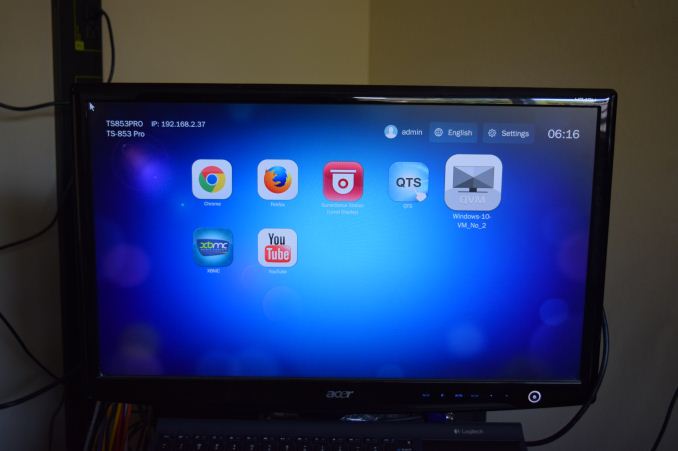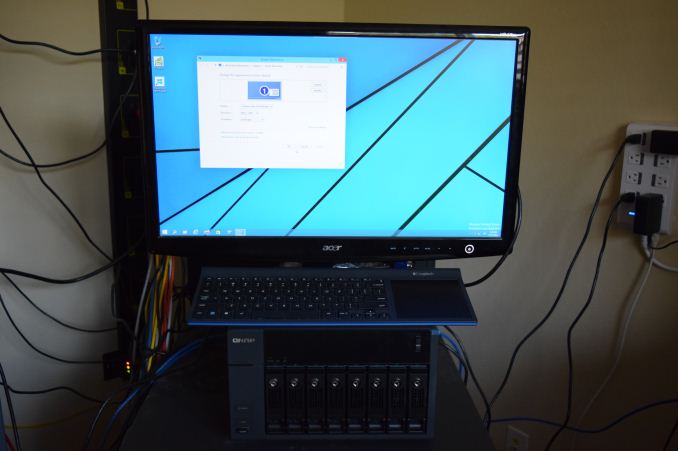QNAP TS-853 Pro 8-bay Intel Bay Trail SMB NAS Review
by Ganesh T S on December 29, 2014 7:30 AM ESTQNAP's HD Station - QvPC Explored
Over the last few years, QNAP has been introducing various interesting packages for their QTS operating system. XBMC was one of the first to take advantage of the HDMI display output on their NAS units. Slowly, a few other packages such as web browsers, NAS management interfaces and YouTube were introduced. Recently, QNAP decided to bundle all these packages under the Hybrid Desk Station (HD Station) moniker.
The ability to interact with the NAS using a keyboard and a mouse brought it closer to a traditional PC for the average consumer. Virtualization Station was the final piece in the puzzle. QNAP added an option to display the console of each VM on the display output desktop (a QVM option) in the Virtualization Station settings. This enables end users to interact not only with the QTS desktop, but also with a Windows or Ubuntu VM as if it was running on a physical machine.
QNAP's HD Station Interface with QVM Activated
Recognizing the big leap made in HD Station using QVMs, QNAP has opted to do a branding exercise - QvPC - for this feature set. In addition to QVMs, HD Station also includes a local output for the tracked surveillance cameras, XBMC with HD audio bitstreaming and other miscellaneous features. QNAP's product page for HD Station adds more marketing detail to what we have covered above.
Windows 10 on a QNAP TS-853 Pro-8G - QvPC
Our usual NAS evaluation routine doesn't load up the NAS with non-NAS aspects while processing benchmarks. For the TS-853 Pro-8G, we did one pass with all four network links bonded and no extra packages active. However, with running VMs being a very attractive feature of the TS-x53 Pro series, we added two sets of benchmarks for the multi-client scenarios after configuring two Windows 10 VMs (two cores, 2 GB RAM and one dedicated network link each). This configuration left the other two network ports free for bonding / external traffic. The CPU cores themselves had to be shared between the VMs and the main NAS tasks (as all four cores ended up getting allocated to the VMs).
- 1 QVM: A Windows 10 VM with QVM configured was activated. PC Mark 8's 'Work' workload was run in a loop with HDMI output enabled, while the rest of the NAS was subject to storage traffic over the bonded network links
- 2 VMs: QVM was de-activated. Two Windows 10 VMs were configured for access via Remote Desktop. PC Mark 8's 'Work' workload was run in a loop on both VMs, while the rest of the NAS was subject to storage traffice over the bonded network links.
In addition to the above Virtualization Station configuration, we also found an interesting caching aspect in QTS. Our benchmarks are processed after turning off the write cache (EXT4 delay allocation) for all NAS units. However, QTS, in addition to the EXT4 delay allocation, has an additional system cache setting at the volume level. The large amount of RAM in the system (8 GB) also skewed the results quite a bit with the system cache settings enabled. QNAP is also one of the first COTS NAS vendors to support SMB 3.0. Obviously, this is available only for Windows 8 and Windows Server 2012 R2 and later operating systems. We tested out SMB 3.0 with a Windows 8 VM in our NAS testbed. In the rest of the review, we try to address as many different combinations as possible in the benchmarks.












58 Comments
View All Comments
Adrian3 - Tuesday, December 30, 2014 - link
This guy mentions a special transcoding chip: https://forums.plex.tv/index.php/topic/126237-qnap.....and that it's only usable by Qnap's own software - and I wouldn't be using that anyway.
Still not a deal breaker for me - but maybe I should consider some other options.
nathanddrews - Tuesday, December 30, 2014 - link
I browsed the manual and they have special drivers and software to enable the hardware transcoding. The transcoding software has two functions: "real-time for up to five devices" but doesn't specify at what resolution, then also an pre-transcoded option where it will make up to five .MP4 versions of the source video at different resolutions (240/360/480/720/1080) that are simply streamed "as is". The manual is clear enough though that this specific model has dedicated transcoding hardware that uses its own software/drivers to operate. You should probably contact them first if you plan on using Plex or something.ganeshts - Tuesday, December 30, 2014 - link
It can definitely do five stream simultaneous hardware accelerated transcoding using the built-in Quick Sync engine.I have tested it and it works beautifully, but only with QNAP's own mobile apps for real-time processing. You can also set up offline accelerated transcoding if you want to use other playback apps / have plenty of disk space to spare.
I do have a small piece coming up talking about hardware accelerated transcoding in NAS units.
nathanddrews - Tuesday, December 30, 2014 - link
I'd love to see that piece, I can't get QS to do more than one Blu-ray transcode.Gigaplex - Wednesday, December 31, 2014 - link
Are you sure it's using Quick Sync? If it is, then 3rd party software shouldn't have much trouble making use of it.ganeshts - Wednesday, December 31, 2014 - link
I am quite confident that it uses Quick Sync - in particular, it just uses a customized build of ffmpeg with Quick Sync support [ https://trac.ffmpeg.org/ticket/2591 ]mhaubr2 - Monday, December 29, 2014 - link
I like the idea of a shoot-out or comparison with DYI solutions.ap90033 - Friday, January 2, 2015 - link
Yes please!ap90033 - Friday, January 2, 2015 - link
I have been trying to figure out a good fast ZFS NAS but cant come close to the price tag of this. Am I missing something? I am trying to build something that would hold at least 8 drives (like this unit). ECC Ram and controllers, etc jack the price up a bit...fmaxwell - Sunday, April 30, 2017 - link
IT professionals buy NASs just like they buy any other server. Any corporate IT director earning his pay knows that it's idiotic to have his staff building an 8-bay NAS when he can buy one this cheaply. If he's got any experience, he's seen ballooning costs and missed deadlines when some in-house, build-it-yourself project runs into trouble. By the time you add burdened labor on top of the parts cost, most companies recognize that having the IT staff build a NAS makes about as much sense as having the cafeteria staff start a dairy farm.As for home users, get some perspective. When I started out in computers, a single hard drive or a dumb terminal cost more than this. I swear to God that computer prices could drop to an average of $10 for a home-built desktop PC and someone would be posting that it's "madness" for a home user to spend $14 for a pre-built system with a warranty.
I bought this NAS and loaded it up with 8 3TB WD Red drives for my home network. The whole thing cost me under $1,800. How can anyone get all riled up about that when it gives them 18TB of RAID 6 network storage and can act as a server for Wordpress, email, media, etc.? Doesn't your time have any value at all?